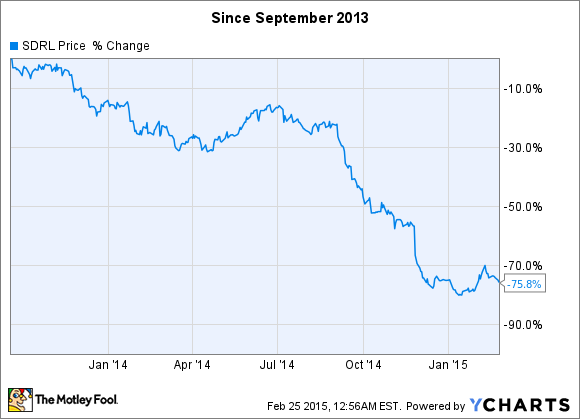Investors in Seadrill (SDRL) have been hammered over the past couple of years:
Not trying to add insult to injury here; after all, I'm a shareholder, too. And the truth as represented on the chart above ... well, man, that truth sure hurts. Here we are today, and Seadrill is scheduled to release financial results for the fourth quarter and full year on Feb. 26. What can shareholders expect? Will the results be better than expected, or could things possibly get worse?
Let's take a closer look.
Let's go to the tape
When Seadrill last reported earnings, investors got a mega-bombshell in the suspension of the company's dividend. For several years, the company's yield was the highest of all its offshore drilling peers, and everyone seemed to believe that the company's superleveraged bet on newer, more capable drilling vessels would pay off with big returns.
The problem? Nobody saw the end of $100 oil coming, much less the prolonged sub-$60 environment that will last for nobody-knows-how-long:
Brent Crude Oil Spot Price data by YCharts.
Why exactly did Seadrill have to suspend its dividend?
Here's a hint:
SDRL Total Dividends Paid (TTM) data by YCharts.
In short, the company has been doing two things: issuing new debt to pay for new ships, and paying massive amounts of cash in dividends. Whether you want to say the company was using the debt to pay the dividend or not, the reality is this: Leverage and an unexpected collapse in oil prices are creating a near "perfect storm," and it's one that could get worse, like it or not.
Cracks in the fortress?
Just recently, we learned that Seadrill's backlog -- which had been seen as a real source of strength -- may not be as rock-solid as many expected. Typically, Seadrill's contracts are as firm as it gets, and noncancellable. However, the risk that we now face is increased uncertainty with what is on the backlog, after Seadrill announced that one of its deals with Petrobras -- worth $1.1 billion -- was being removed from the backlog. Apparently, the contract had never been signed, and Petrobras wanted to return to the negotiating table.
Here's the thing: Investors' trust was shaken when we were told that the dividend was sustainable for at least the next year only to have that rug pulled out from under us the next quarter. Sure, oil prices declined very rapidly soon after that earnings announcement, but an overconfident -- at best -- management team got sideswiped just like the rest of us.
The point: Is the Petrobras deal an aberration, or are there more handshake deals on the backlog that could come back to bite the company? Only time will tell.
Playing it safe
In management's defense, they have made some very hard choices lately, and while maybe we all would have liked to see them happen sooner, the company is taking steps to build up a margin of safety that it probably should have had in place already.
As the chart above shows, Seadrill paid out nearly $2 billion in dividends over the past 12 months, so it freed up a substantial amount of future cash flows. Yes, as part of the divvy suspension, the board approved share repurchases of up to 10% of shares outstanding, but at recent prices, that's less than $600 million. However, the loss of the Petrobras deal means that the company has about $300 million in annual revenue from two drillships that's now absent.
And in the current market environment, it's not clear how soon Seadrill will be able to get the vessels working, or how much it will get for them. At best, it will likely see dayrates cut from $600,000 per day to maybe $400,000, but probably a little less.
Current contracts provide some certainty, but there's another potential problem around the corner
Seadrill has this in its favor: Around 80% of its vessels are under contract until 2016, meaning that much of the revenue and cash flows for the year are lined up, even if oil prices stay down for an extended period.
However, there's further risk for Seadrill as soon as the end of the year. The company suspended its newbuilding program in 2014, but it still has another 16 vessels under contract to buy, and has already paid $1.6 billion toward them. Thirteen of these are scheduled to be delivered in 2015, and of that total, nine are without a contract as of this writing. Seadrill has stated that it is likely that a number of the drillships scheduled to be delivered late in the year will be delayed by the shipyards, and frankly, that's great news if it happens.
However, "likely" isn't a certainty, and the reality is, the company will need to add substantial new debt to meet its remaining $4.7 billion obligation for newbuilds.
Looking ahead
When things are at their worst, it can be really hard to see a way forward, and I think that's probably where we are with Seadrill right now. However, the race isn't over, and there's a good chance that the steps the company is taking will pay off, and Seadrill can begin deleveraging.
We get our first indication of how it's working out for the company on Feb. 26. Stay tuned.






